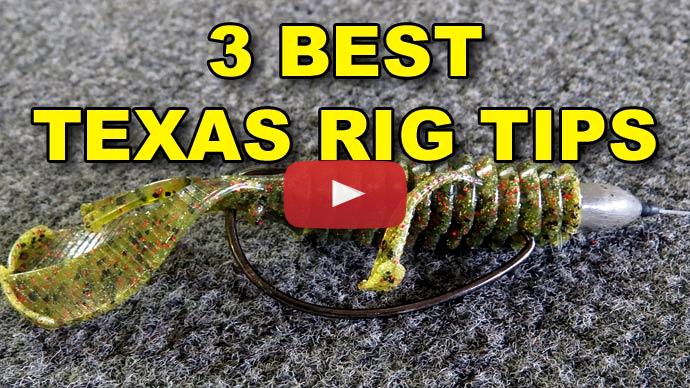Hey, guys, David the Fishin' Pastor here for KastKing and BassResource.com and today we're talking about the Texas rig. The Texas rig is by far one of the most widely used rigs in all of bass fishing and it's definitely one of my favorites. So today I wanna teach you about how to rig up and properly fish the Texas rig. Okay, so let's start off by talking about the gear that I use to throw a Texas rig on and the different components that make up a Texas rig. When I'm throwing a Texas rig, I like to use fast reels and rods with a little bit more power behind them. So today I'm using my KastKing Speed Demon Baitcast Reel. This is a 9.3:1 gear ratio reel. It's a very high-speed reel. And for the rod, I'm using my KastKing Royale Legend rod. This is a 7 foot 3, fast action, heavy rod so it has that backbone, it has that power but it also has that tip so that I can feel those bites.
So here's some of those items that you need for a Texas rig. Number one, bullet weights. Now, either in lead or in tungsten but you want bullet weights because they have a flat bottom that can sit flush on top of the bait. Number two, you'll want some bobber stops or punch stops. Now, these are kind of debated on whether or not you need them or what situations you need them in but it's always a good thing to have for Texas rigs.
Now, you'll also need some hooks. Now, there's different styles of hooks, there's the more straight shanked hooks, and then there's the extra wide gap hooks. And I use both depending on the situation. Now, if I'm casting my Texas rig out more into open water, I usually use the wide gap hook. I really like how it sits flush on those baits. And then if I'm flipping into cover I'm gonna use more of a flipping style hook which even has a grip in there so that the bait doesn't slide down the hook as easily. The other thing that will determine what kind of hook I use is the type of bait that I'm throwing.
So let me talk about some baits real quick. So when it comes to the Texas rig you can throw such a wide variety of baits. One of my favorites are the creature baits or the hog style baits. Here, like this one. And I'm generally throwing this on an extra wide gap hook. With these I can cast them out, I can flip into cover, whatever I need. Now, if I'm doing some more heavy flipping and I'm using those flipping style hooks, those straight shank, then I actually like the beaver style baits. I feel like if these actually go into cover a little bit better if you're throwing into thick vegetation, things like that, I'm generally gonna throw this style bait but, again, the possibilities are endless. You can throw a stick bait or Senko style bait, you can throw ribbon tail worms, honestly, you can throw such a wide variety of baits, and the great thing is that with a Texas rig, you're throwing a weedless presentation so you're able to get in and out of cover a lot easier than with other presentations.
First, you're gonna start off with your bobber stop or your punch stop and you wanna add that onto there. Now, if you're casting your Texas rig out more this isn't as necessary as if you're flipping but you could always have it and slide it up the line, and when you do need it you could just slide it back down rather than having to cut and retie and add one afterwards. So the next thing you wanna do is slide your weight onto the line. Now, again, you can use lead or tungsten and I know a lot of people are moving over to tungsten because they're more eco-friendly but when it comes to fishing they're smaller weights and they're more dense. Now, if you're flipping into heavy cover and using a 1 ounce led weight you have the big possibility of blowing that fish's mouth wide open as opposed to using a tungsten weight.
Now, the next thing you wanna do is tie on your hook. Now, I'm using the extra wide gap for this example but, again, you can use whatever hook you'd like. And my knot of choice is the Palomar knot. It's just the one I feel more comfortable with. I feel like it's a very strong, sturdy knot. But if I'm flipping into some really heavy cover and I'm using a punch rig, for example, I'm gonna use something like a Snell knot for a little bit more power. Okay, so now that we've talked about the equipment and the rigging let's talk about actually fishing the Texas rig. Now, you can either cast it out, if you'd like, or you can flip it short distances into cover.
Let me show you how to cast it out and retrieve it properly. So you're gonna start off just by casting it out like any other bait. And what you want is to let it fall on a semi-slack line. If your line is too tight, what's gonna happen is, it's gonna hit that water and just pendulum all the way back to you and miss that whole area. But if your line is too loose and a fish decides to come and bite it as it's falling, you're not gonna feel that bite, so a semi-slack line is best.
So once your bait hits bottom, and you feel it hit bottom, what you wanna do is just reel down a little bit, just to kinda tighten up your line. But you don't wanna use your reel to bring in that bait. What you wanna do is use your rod and just bring you rod back like this. And then what you wanna do is just reel down the flat, bring it back and reel down the flat. You can actually feel a lot of the bottom like that and it's a great way to kinda know the conditions that you're fishing. But, also, you're crawling it kinda like a crawfish and that's what you're kinda trying to imitate there. Now, you can be a little bit more aggressive if you want, if the fish are a little bit more aggressive. You can hop it, you can even swim it a little bit but really when it comes to Texas rig fishing you just wanna kind of drag it, and then just reel down the slack, drag it up. And so what happens is when you feel that bite, you feel that kind of tick, or you feel the fish just coming, just to destroy that bait, you wanna reel down and then set that hook and that's gonna drive the hook up into the fish's mouth.
Now, when it comes to flipping the bait, it's a short distance cast and it's gonna be pretty much the same thing. So you wanna get your bait out there, whether you're flipping or pitching, and you wanna, again, let it fall on some semi-slack line. Now, because you're throwing to a specific target, you can actually leave it there a little bit longer, and what I do is, I let it get in there and I shake it a little bit, and then I'll move it up a little bit, reel down the slack, shake it a little bit, and then move it up. And if I feel any kind of resistance, if I feel a rock, if I feel a branch, anything like that, then I'm just gonna stop and just shake it a little bit. And that gives a little bit of movement in the water, if there's a fish there, it tends to drive them crazy.
All right, there you go. Hopefully you learned something new about the Texas rig or at least got a good refresher about it. Remember to subscribe to the channel, and if you're interested in any of the gear in this video, it'll be linked in the description below. Remember to pray, fish, repeat. God bless, I'll see you in my next video.



